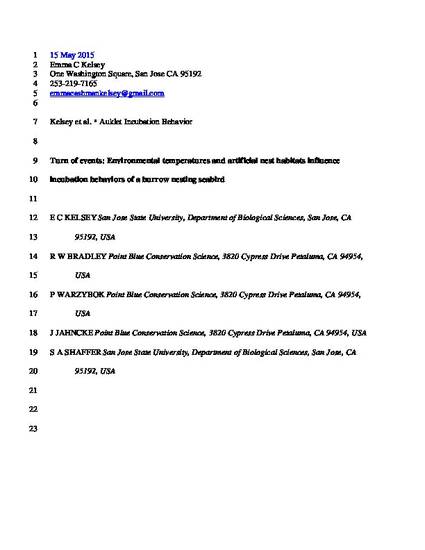
Article
Environmental temperatures, artificial nests, and incubation of Cassin's auklet
Journal of Wildlife Management
(2015)
Abstract
Hatching success in birds is influenced by the temperature and turning rate of the egg, but our understanding of the environmental factors that effect incubation temperatures and egg turning rates in birds is limited. Especially little is known of these effects for species that nest in burrows or crevices, such as the Cassin's auklet (Ptychoramphus aleuticus). On Southeast Farallon Island, California, USA, a subset of the Cassin's auklet (hereafter auklet) population nest in artificial nest boxes. The nest boxes are above ground and made out of a single layer of plywood. Temperatures in unshaded nest boxes can increase significantly with high ambient temperatures (to >35° C). Shaded structures put on top of occupied nest boxes help mediate nest box temperatures, but the effects of elevated temperatures on auklet incubation behaviors and egg viability remain equivocal. We used egg data loggers to measure the temperatures and turning rates of auklet eggs in natural burrows, shaded nest boxes, and unshaded nest boxes on Southeast Farallon Island. Nest box (13.93 ± 1.26° C) and egg (37.43 ± 1.92° C) temperatures were highest and most variable in unshaded nest boxes. Mean hourly egg turning rate was 2.11 ± 2.02 turns/hour and turning rates were greater at night. Egg turning rates also varied with fluctuating nest and egg temperatures, being positively correlated with nest temperatures during the day and negatively correlated with egg temperatures during the night. Our results suggest that nest box design can influence incubation behaviors of breeding birds. As seasonal temperatures and the number of extreme heat events rise, understanding the impacts of temperature on auklets nesting in artificial nests can have positive implications for conservation and management of the species, such as implementing improved artificial nest box designs to prevent overheating of burrow nesting seabirds. © 2015 The Wildlife Society.
Keywords
- Cassin's auklet,
- egg loggers,
- nest boxes,
- egg turning,
- southeast farallon island
Disciplines
Publication Date
November 15, 2015
DOI
10.1002/jwmg.1012
Publisher Statement
This is the Submitted Manuscript of an article that appeared in Journal of Wildlife Management, volume 80, issue 2, 2015. The Version of Record (VOR) may be found at http://dx.doi.org/10.1002/jwmg.1012
SJSU Users: use the following link to login and access the article via SJSU databases.
Citation Information
Emma C. Kelsey, Russell W. Bradley, Pete Warzybok, Jamie Jahncke, et al.. "Environmental temperatures, artificial nests, and incubation of Cassin's auklet" Journal of Wildlife Management Vol. 80 Iss. 2 (2015) p. 292 - 299 ISSN: 0022-541X Available at: http://works.bepress.com/scott_shaffer/50/
